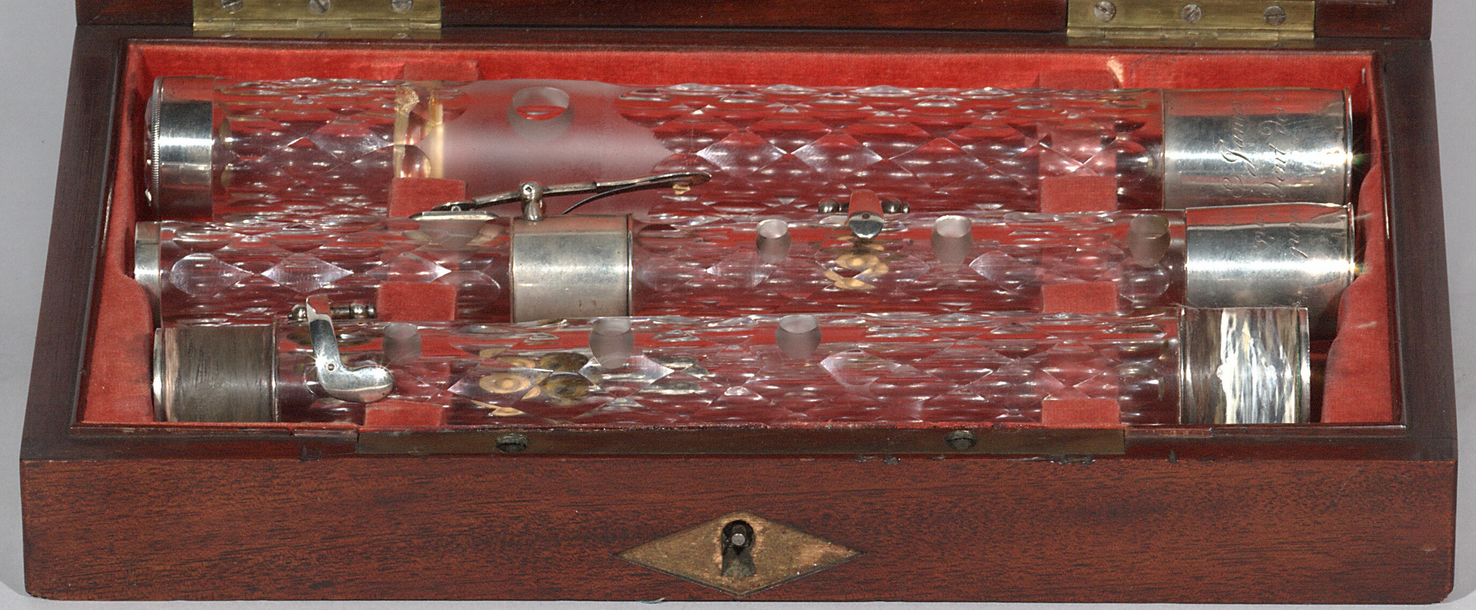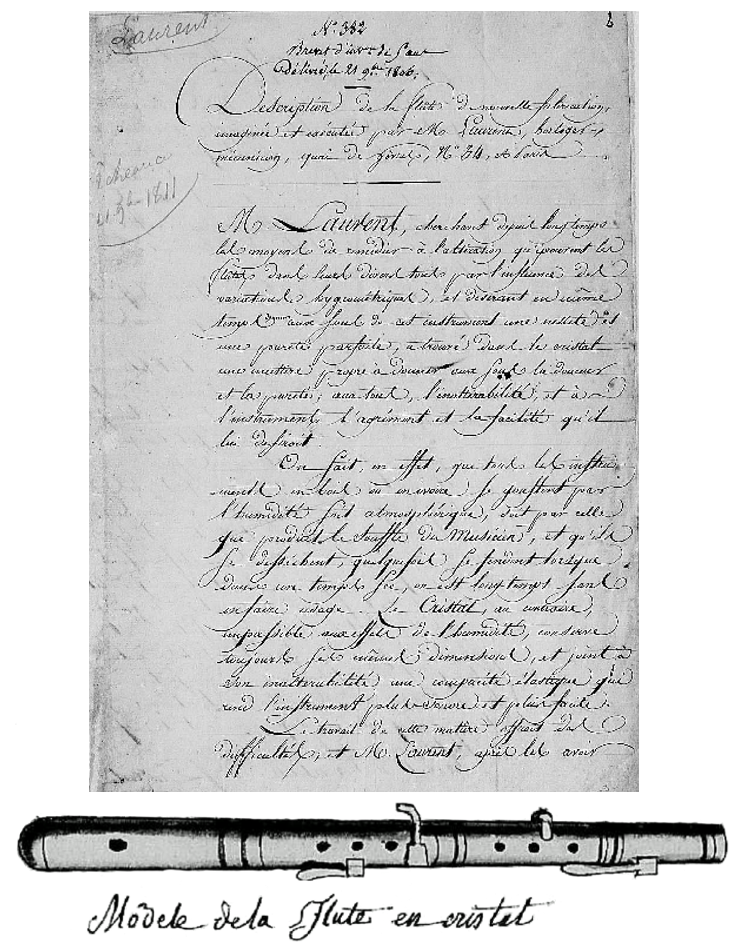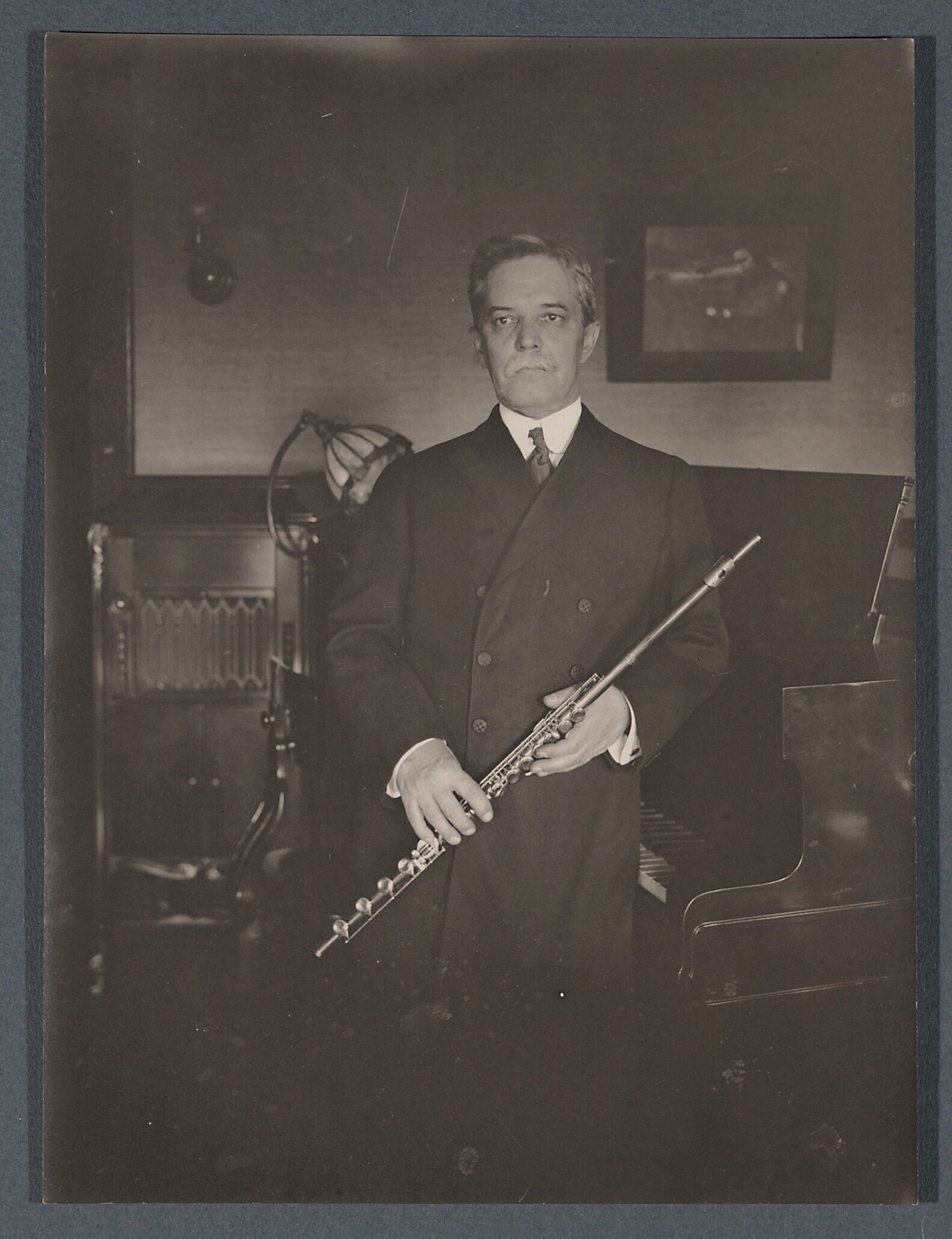Laurent Flute DCM 378, Flute for President James Madison / Flute in C, Dayton C. Miller Collection, Library of Congress.
claude laurent’s glass flutes
In 1941, Dayton C. Miller donated an extraordinary collection of nearly 1,700 flutes and other wind instruments, statuary, iconography, books, music, trade catalogs, tutors, patents, photographs, and glass plate negatives related to the flute to the Library of Congress (LC). Dr. Miller was a prodigious American physicist, acoustician, and astronomer who taught for and conducted research at Case Western Reserve University for more than four decades. Of particular note in the collection are the 18 rare glass flutes, 17 of which were manufactured in Paris by Claude Laurent (December 5, 1774-June 20, 1849) during the first half of the 19th century or, after 1848, by his apprentice J. D. Breton. This is the largest holding of Laurent flutes in the world. Dr. Miller methodically collected the Laurent flutes, covering a distinct range in dates and styles, from simple flute tubes with frosted exteriors to highly decorative flutes with jeweled keys and cut designs. The flutes were made for and sold to amateurs, professional flute players, and collectors, or were presented to world leaders. The collection is highlighted by a particularly beautiful Laurent flute that was made for President James Madison, pictured above in its original case with each joint separated.
To see results from our technical study of Claude Laurent’s glass flutes, click here.
To read more about Claude Laurent, click here.
To read more about Dayton C. Miller, click here.
Who was claude laurent?
Baptême de Claude Laurent (Baptism of Claude Laurent), 1774, Archives of Haute Marne.
Claude Laurent patented a new type of glass flute in 1806, and these became an early 19th century novelty. Most flutists of the era played flutes of wood or ivory, which were subject to pitch shifting in different temperatures and humidities. Laurent’s patent for “flute en cristal”, a leaded glass flute, maintained its pitch where other flutes would not. Glass flutes went out of style after Laurent's death in lieu of metal flutes, but Laurent’s innovations in the use of pillars to mount the keys became a standard in flute production. Laurent’s flutes were expensive items, made for and sold to prominent flute players and collectors. Several flutes were presented to world leaders. The Library of Congress’ Dayton C. Miller (DCM) flute collection is highlighted by a particularly beautiful flute that Laurent gifted to President James Madison.
Laurent’s patent for “Flûte en Cristal”, 1806, Institut national de la propriété industrielle.
For such a prolific maker of beautiful instruments, there is little known information about the life of Laurent. Research in 2015 focused on Laurent’s personal and professional origins and revealed new information about Laurent. Laurent was born to Etienne Laurent and Anne Juy on December 5, 1774,“Saint-Maurice-lès-Langres”, a very tiny village near Langres in the northeast of France.
Laurent’s original trade was as a clock maker. At some point during his career, he switched to making flutes, as evidenced by his patent for “flute en cristal” in 1806. A review of the patent by the Athenaeum of Arts in Paris states that Laurent was a clock maker by profession, but a musician by personal taste, who was interested for years in the perfecting of the glass flute so that it could not be influenced by temperature nor humidity. The Athenaeum tested the flute with physical tests, such as playing the flute under high and low humidity and at temperatures as high as that of a fireplace. The judgment was positive concerning the durability, sound and appearance of the flute. This flute, or a similar Laurent flute, was awarded a silver medal at the 1806 Paris Exhibition. The patent examiners’ only negative criticism was the flute’s substantial weight. They suggested to solve the issue by fluting (cutting fluted designs) the glass tubes, thus reducing the weight and beautifying the instrument.
To learn more about Laurent, click here.
Dayton C. Miller, Dayton C. Miller Collection, Library of Congress
Who is Dayton C. Miller?
In 1941, Dayton C. Miller (DCM), a renowned physicist and amateur flutist, donated an extraordinary collection of nearly 1,700 flutes and other wind instruments, statuary, iconography, books, music, trade catalogs, tutors, patents, photographs, and glass plate negatives related to the flute to the Library of Congress. Dr. Miller's interests in acoustics and music-making were chiefly responsible for starting the collection on its way, and are reflected in his collection of flutes and wind instruments. Of particular note in the collection are 20 rare glass flutes manufactured in Paris by Claude Laurent during the first half of the 19th century or, after 1848, by his apprentice J. D. Breton. The collection also includes a seemingly related glass piccolo by Charly (ca. 1889). This collection is the largest holding of Laurent flutes in the world and covers a distinct range in dates and styles by Laurent, from simple flute tubes with frosted exteriors to highly decorative flutes with jeweled keys and cut designs. The collection contains, for example, eighteen crystal flutes from the early-nineteenth-century Paris workshop of Claude Laurent, at least one of them, DCM 1063, actually being the work of J. D. Breton, an associate of Laurent who succeeded him. None of the eighteen were too expensive for Dr. Miller to acquire. On the relatively high end was DCM 378, an instrument presented to President James Madison in 1813 that had once been exhibited at the U.S. National Museum (Smithsonian Institution) before 1903. The cost to Miller in 1923 was two hundred dollars, plus $3.30 for packing and shipping. In 1941, Dayton C. Miller donated his collection of books, prints, photographs, music, correspondence, trade catalogs, statuary, and more than seventeen hundred flutes and other wind instruments to the Library of Congress. It was Miller's vision, ahead of its time, that musical instruments, when preserved in their original condition, are invaluable historical documents. In order to learn how old instruments sound, we are far better served, he believed, by replicating them from original specimens than by trying to repair those specimens, thus destroying their archival value in the process.
To learn more about Dayton C. Miller, click here.








